Post by Kathy on Jan 26, 2006 1:12:27 GMT -5
How to build A Dog House
34" high x 32" wide x 48" long

This kennel will accommodate a large dog but is still suitable for smaller dogs.
The kennel is constructed out of 1x6 stock (treated lumber) for the floor and roof, 2x2 stock for the framing, 2x2 stock (treated lumber) for the under floor skids and one sheet of 48" x 96" x 3/8" thick exterior type plywood from which the walls are cut.
Note 1. About pressure treated lumber
Do not use treated lumber on any parts the dog may chew.
Pressure treated lumber (PT) contains preservatives that can be toxic to your dog.
In this project we have opted to use pressure treated lumber for the roof, floor and skids, as it is unlikely the dog will chew these parts.
The walls and inside framing are of untreated lumber, as these are the parts a dog is most likely to gnaw.
**If you have any reservations and/or a dog that chews everything in sight, then use untreated lumber for the entire kennel.
***However if you opt to do this, remember that all untreated lumber exposed to the weather (excepting lumber that has a natural resistance to rot or decay) must be well sealed and painted to prevent moisture uptake and prolong the life of the lumber.
Note 2. The plywood
Exterior plywood has a waterproof, phenolic or melamine glue line, referred to as WBP - water boil proof.
If the exterior plywood is neither pressure treated nor made from a durable rot-resistant wood, then the plywood will also need to be sealed and painted to prevent moisture uptake and prolong its life.
Note 3. Painting
Untreated lumber should be painted using Wood Primer, Enamel Undercoat and Super Gloss Enamel. When dried the paint would be non-toxic to dogs chewing, but any damage taking the paint system back to bare wood would eventually allow water and increase the danger that the lumber may eventually begin to rot.
Construction details
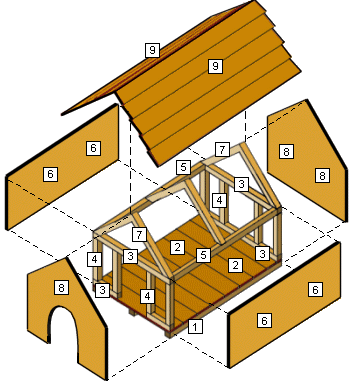
Cutting list......
ITEM No------MATERIAL / SIZE---AMOUNT& LENGTH---DESCRIP
(#1) 2x2 treated stock 3 @ 48" ............Under floor skids
(#2) 1x6 treated stock 8 @ 31-1/4" ........... floor
(3) 2x2 stock 4 @ 31-1/4" .....Top and bottom plates for front and rear wall frames.
(#4) 2x2 stock 8 @14" ........front and rear wall frame studs
(#5) 2x2 stock 2 @ 44" ............Side wall top plates
(#6)&(#8) 1 sheet 48" x 96" x 3/8" thick exterior type plywood....wall cladding
cutting dimensions as per pattern below
(#7) 2x2 stock 6 @ 22" (long point) with 45deg angle cut each end ..Rafters. see cutting dimensions in diagram below
(#9) 1x6 treated stock 10 @ 60" ............Roofing boards
Step one
Pre-cut all the skids, flooring, plates, studs and rafters to the lengths as stated above and cut the plywood wall panels from the plywood sheet to the pattern as shown on the diagram below.
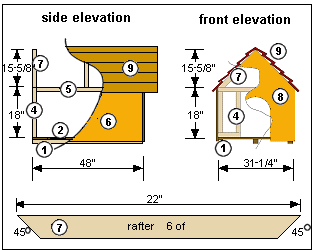
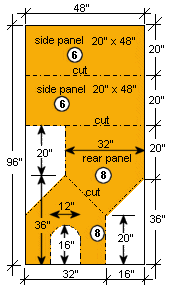
Step two
Fix the 8 floorboards (#2) to the three under floor skids (#1) with 3" galvanized nails.
Ensure the finished floor dimensions are 31-1/4" x 48". The three under floor skids should be evenly spaced with two each side and one in the middle.
Step three
Nail the front and rear frames comprising of top and bottom plates (#3) and studs (#4) together.
Overall frame dimensions of both front and rear frame should be 18" high and 31-1/4" wide.
Ensure the placement of the intermediate studs allow enough of a gap (12") for the doorway.
See diagrams for reference.
Stand and fix the front and rear frames in place at each end of the floor.
Step four
Fix the 2 sidewall top plates (#5) in place. See diagrams for reference.
Step five
Fix the wall panels (#6,#8) to the frames using 2" galvanized flathead nails.
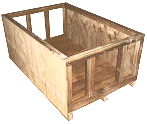
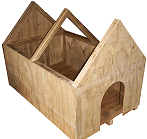
Step six
Fix the rafters (#7) in place.
Step seven:
Fix the 10 roofing boards (#9) (5 each side) to the rafters beginning with the lowest board.
The roof boards are 60" long and the kennel is 48" long, therefore the roof boards should overhang each end of the kennel by 6".
The first roofing board should overhang the sidewalls by 1" to 2".
Fix the rest of the roofing boards in place checking that all overlaps are even.
All done.
Author: Les Kenny
34" high x 32" wide x 48" long

This kennel will accommodate a large dog but is still suitable for smaller dogs.
The kennel is constructed out of 1x6 stock (treated lumber) for the floor and roof, 2x2 stock for the framing, 2x2 stock (treated lumber) for the under floor skids and one sheet of 48" x 96" x 3/8" thick exterior type plywood from which the walls are cut.
Note 1. About pressure treated lumber
Do not use treated lumber on any parts the dog may chew.
Pressure treated lumber (PT) contains preservatives that can be toxic to your dog.
In this project we have opted to use pressure treated lumber for the roof, floor and skids, as it is unlikely the dog will chew these parts.
The walls and inside framing are of untreated lumber, as these are the parts a dog is most likely to gnaw.
**If you have any reservations and/or a dog that chews everything in sight, then use untreated lumber for the entire kennel.
***However if you opt to do this, remember that all untreated lumber exposed to the weather (excepting lumber that has a natural resistance to rot or decay) must be well sealed and painted to prevent moisture uptake and prolong the life of the lumber.
Note 2. The plywood
Exterior plywood has a waterproof, phenolic or melamine glue line, referred to as WBP - water boil proof.
If the exterior plywood is neither pressure treated nor made from a durable rot-resistant wood, then the plywood will also need to be sealed and painted to prevent moisture uptake and prolong its life.
Note 3. Painting
Untreated lumber should be painted using Wood Primer, Enamel Undercoat and Super Gloss Enamel. When dried the paint would be non-toxic to dogs chewing, but any damage taking the paint system back to bare wood would eventually allow water and increase the danger that the lumber may eventually begin to rot.
Construction details

Cutting list......
ITEM No------MATERIAL / SIZE---AMOUNT& LENGTH---DESCRIP
(#1) 2x2 treated stock 3 @ 48" ............Under floor skids
(#2) 1x6 treated stock 8 @ 31-1/4" ........... floor
(3) 2x2 stock 4 @ 31-1/4" .....Top and bottom plates for front and rear wall frames.
(#4) 2x2 stock 8 @14" ........front and rear wall frame studs
(#5) 2x2 stock 2 @ 44" ............Side wall top plates
(#6)&(#8) 1 sheet 48" x 96" x 3/8" thick exterior type plywood....wall cladding
cutting dimensions as per pattern below
(#7) 2x2 stock 6 @ 22" (long point) with 45deg angle cut each end ..Rafters. see cutting dimensions in diagram below
(#9) 1x6 treated stock 10 @ 60" ............Roofing boards
Step one
Pre-cut all the skids, flooring, plates, studs and rafters to the lengths as stated above and cut the plywood wall panels from the plywood sheet to the pattern as shown on the diagram below.


Step two
Fix the 8 floorboards (#2) to the three under floor skids (#1) with 3" galvanized nails.
Ensure the finished floor dimensions are 31-1/4" x 48". The three under floor skids should be evenly spaced with two each side and one in the middle.
Step three
Nail the front and rear frames comprising of top and bottom plates (#3) and studs (#4) together.
Overall frame dimensions of both front and rear frame should be 18" high and 31-1/4" wide.
Ensure the placement of the intermediate studs allow enough of a gap (12") for the doorway.
See diagrams for reference.
Stand and fix the front and rear frames in place at each end of the floor.
Step four
Fix the 2 sidewall top plates (#5) in place. See diagrams for reference.
Step five
Fix the wall panels (#6,#8) to the frames using 2" galvanized flathead nails.


Step six
Fix the rafters (#7) in place.
Step seven:
Fix the 10 roofing boards (#9) (5 each side) to the rafters beginning with the lowest board.
The roof boards are 60" long and the kennel is 48" long, therefore the roof boards should overhang each end of the kennel by 6".
The first roofing board should overhang the sidewalls by 1" to 2".
Fix the rest of the roofing boards in place checking that all overlaps are even.
All done.

Author: Les Kenny
